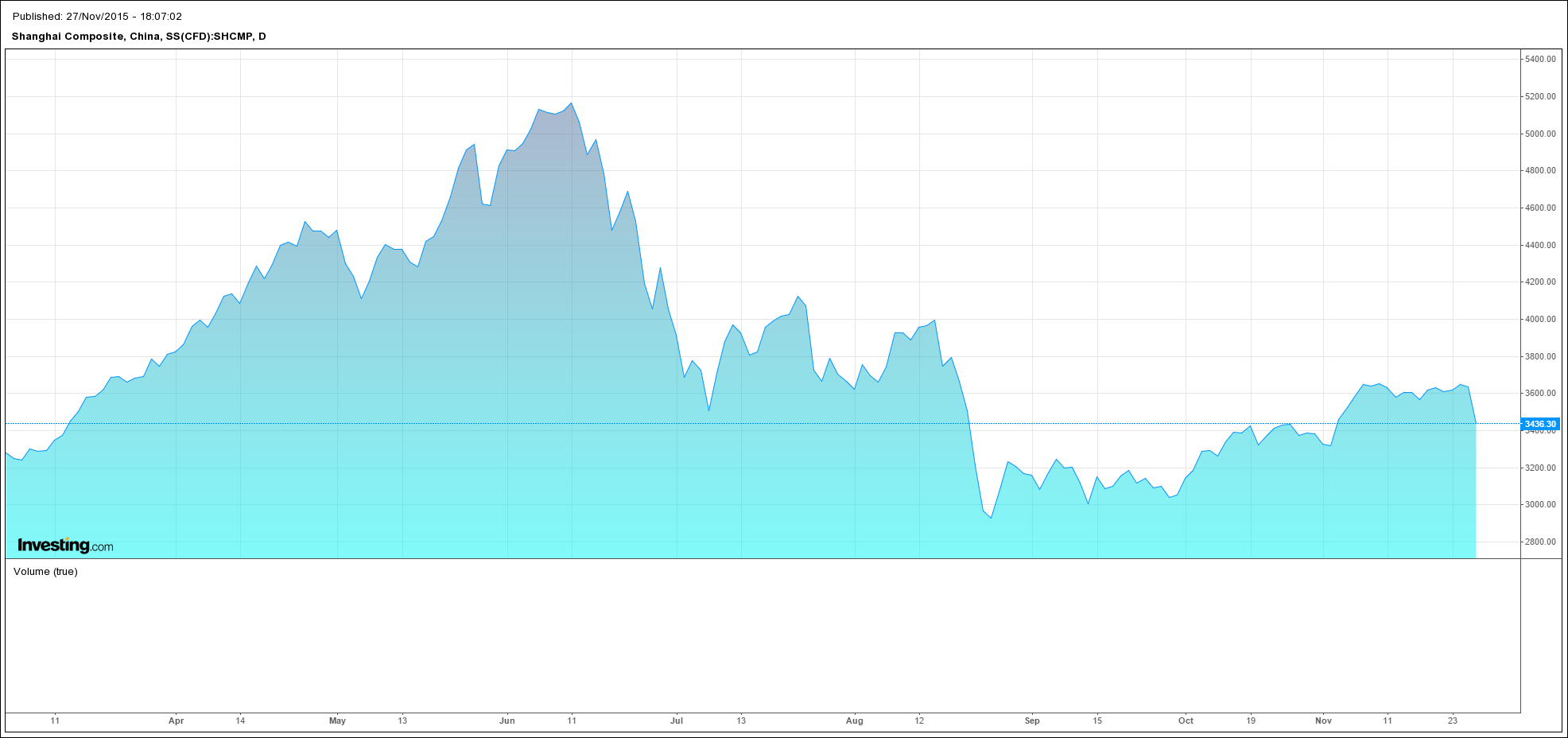The mood has soured in the past couple of weeks and the Shanghai analog is entering the period when, if history keeps rhyming as before, the market is due to turn lower after a 6% drubbing on Friday:
Stock market specific headlines are deteriorating: China Stock Bulls Hit Breaking Point as State Dials Back Support and China Calm Shattered as Brokerage Probe Sparks Selloff in Stocks
China’s stocks tumbled the most since the depths of a $5 trillion plunge in August as some of the nation’s largest brokerages disclosed regulatory probes, industrial profits fell and two more companies said they’re struggling to repay bonds.
The Shanghai Composite Index sank 5.5 percent, with a gauge of volatility surging from the lowest level since March. Citic Securities Co. and Guosen Securities Co. plunged by the daily limit in Shanghai after saying they were under investigation for alleged rule violations. Haitong Securities Co., whose shares were suspended from trading, is also being probed. Industrial profits slid 4.6 percent last month, data showed Friday, compared with a 0.1 percent drop in September.
And from Bloomberg:
“While government intervention has typically showed up in the last hour of trading, the Shanghai Composite extended losses in the final 60 minutes to close near its lows of the day.”
“I don’t think any government can support the stock market forever,” said Paul Chan, the Hong Kong-based chief investment officer for Asia excluding Japan at Invesco.
Recent wider headlines on China have been negative: Another December Devaluation Call; Chinese State Owned Mining Assoc Asks Govt to Buy Their Inventory; and Hope For China’s Economy Smashed To Pieces.
Now another devaluation call has been made (making it three in as many days) based on the IMF lowering the yuan’s weight in the SDR basket: IMF Ratio Concern Depresses Yuan as Mizuho Warns of Further Drop
The yuan fell toward a three-month low amid concern China will win a smaller weighting in the IMF’s Special Drawing Rights than some analysts predict.
While International Monetary Fund staff estimate a weighting of 14 to 16 percent, the market consensus is for 10 percent because of the currency’s limited usability, according to Mizuho Bank Ltd.
Even the China Daily is posting negative views: Demand unlikely to boost yuan despite basket inclusion
The International Monetary Fund’s decision to include the yuan in the Special Drawing Rights basket will not directly increase the demand for yuan assets. Also, the implicit endorsement of the yuan as a reserve asset is unlikely to sway the decisions of global asset managers. Indeed, China’s market interventions this year in response to capital outflows and the bursting of the equity bubble provide strong reasons for them to steer well clear.
Defaults continue to mount. Bloomberg: China’s Bond Stresses Mount as Two More Companies Flag Concerns
A Chinese fertilizer maker and a pig iron producer have flagged bond payment difficulties, adding to signs of stress in the nation’s corporate note market after at least six defaults this year.
Jiangsu Lvling Runfa Chemical Co., based in the eastern city of Suqian, is asking its guarantor to repay 53.1 million yuan ($8.3 million) in bond principal and interest due Dec. 4, according to a statement posted on Chinamoney’s website. Sichuan Shengda Group Ltd., based in the southwestern province of Sichuan, is uncertain it can repay notes due in 2018 that holders can opt to sell back early on Dec. 5, it said in a statement on the same website Thursday.
…The guarantor of Jiangsu Lvling Runfa’s bond is Jiangsu Re-Guarantee Co.
Jiangsu Re-Guarantee says they will fulfill their obligation if the firm indeed cannot pay its debts. Anytime a credit guarantee is involved a red flag should go up because if they cann’t cover the guarantee, all the loans guaranteed by the firm could be called by banks. The Chinese headline says credit market pressure is as big as a mountain. 本周两家公司发出违约警报 债市压力山大
Finally, Chinese economic data continues to deteriorate aside from a pick-up in some consumer data points. If China were rebalancing, this would be a positive sign, but the consumer is a lagging indicator. Even in the U.S., the consumer sector is overweighted and the manufacturing sector discounted because GDP doesn’t fully measure it (See: GDP Stands For Garbage Data Point). The summary of the Chinese data points:
Price: October 70 City house prices continue weak rebound. Producer prices hit a new low last week: 中国经济仍未见起色 中观行业上中下游继续探底
Demand: Downstream real estate, household appliances weaker, passenger car picked up. Midstream steel, cement, chemicals weaken. Upstream coal is still weak, weak freight.
Inventory: Downstream real estate remains high, passenger cars, home appliances fair. Midstream steel worsened, cement deteriorated, chemicals fair. Upstream coal, nonferrous metals still high.
Hope died in China last week.


